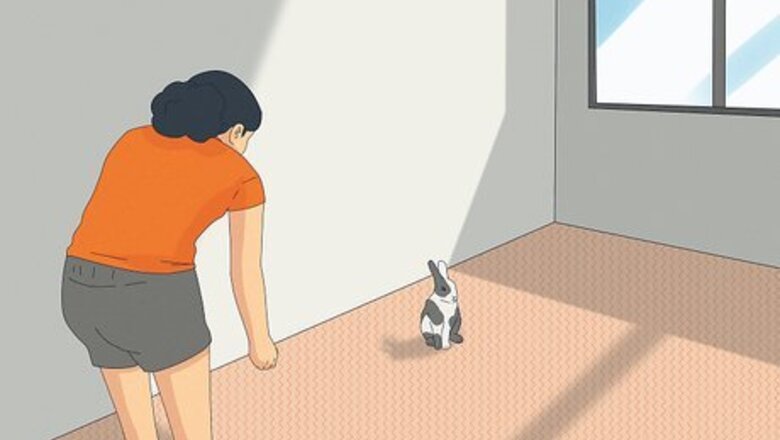
views
Approaching Your Rabbit
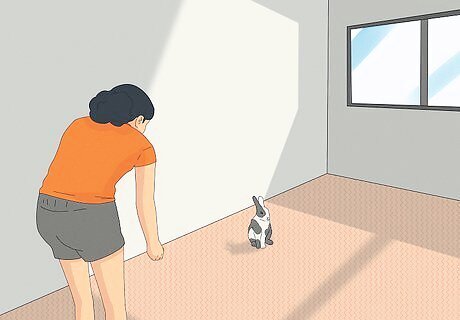
Let the rabbit know that you're coming. Remember that rabbits are prey animals. That means they are naturally used to being hunted, so if you startle them they'll run away. Accordingly, you should always give your rabbit a warning that you're approaching so he won't get scared. Don't sneak up behind the rabbit. If you enter the room and your rabbit is facing away from you, give him a signal you're in the room. Speak softly or make light kissing noises. This way, he won't feel like you're sneaking up on him.
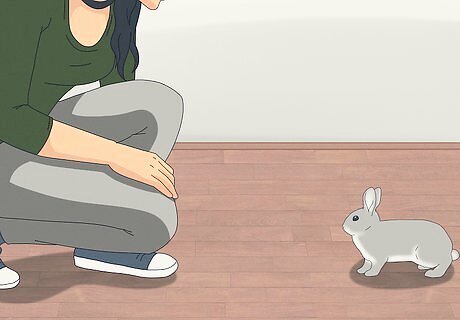
Stay low to the ground as you approach your rabbit. Rabbits can be startled by something large like you approaching them, even if they already know you're there. Especially if your rabbit has a nervous disposition or isn't used to being handled yet, approach slowly and try to stay low. That way you can avoid startling your rabbit as you approach.
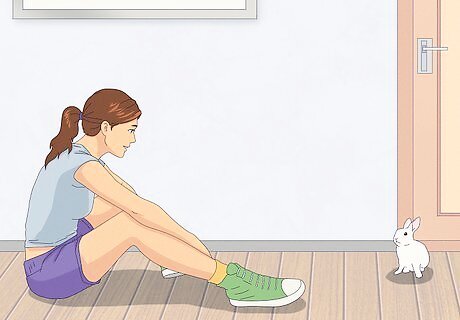
Sit down and let the rabbit come to you. Grabbing your rabbit or forcing him to come over is a good way to scare him and get bitten. When you're close enough, you should let the rabbit come to you to avoid this. Allowing him to move at his own pace will ensure that he's comfortable and wants to come over to you. This will make it easier for you to pet him, play with him, and pick him up. If your rabbit is new to the house, he might be hesitant to approach you right away. It is important to not force him to come to you. Keep up this process for a few days until he begins approaching you to ensure that he is comfortable when you start petting him.
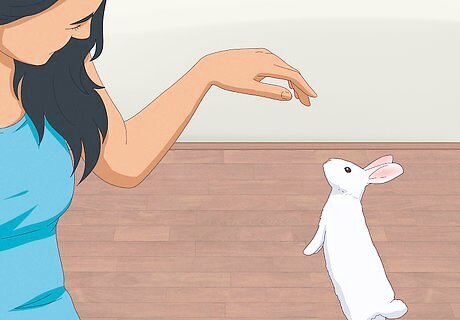
Show the rabbit your hand. Move it towards the rabbit gently, placing it at eye level and off to the side. Allow the rabbit to sniff your hand, at its convenience. You might also want to give your rabbit a treat at this point, especially if you just got him and he isn't used to you yet. Hand-feeding is a good bonding exercise, and it will also teach your rabbit that you aren't a threat and he can approach you safely.

Avoid startling the rabbit when showing him your hand. While the hand presentation is part of bonding, you could scare your rabbit if you do it improperly. Keep the following in mind to make sure your rabbit stays happy and comfortable during this process. Present your hand to the rabbit's front end, not back. Otherwise you'll scare him when he realizes your hand is approaching. Rabbits can't see directly in front of their face or under their jaw. Bring your hand in from slightly off to the side to ensure that your rabbit sees it coming. Do not put your hand below the rabbit's nose. While presenting your hand under the jaw shows submission to dogs and cats, it has the opposite presentation in rabbits, as a dominant rabbit will approach another and demand to be groomed by the other by lowering its head under the other rabbit's nose. If you approach a nervous rabbit this way, it will likely make it more nervous, and if you do this to a territorial or dominant rabbit, you might get nipped.
Petting Your Rabbit
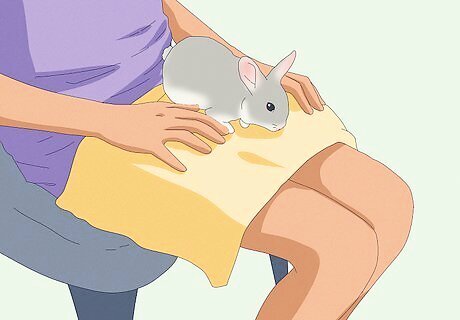
Make sure your rabbit is comfortable before you start petting him. Remember that rabbits can have nervous dispositions and may not enjoy getting pet unless they're ready for it. If your rabbit has approached you, it is a signal that he is comfortable and open to being pet. Until your rabbit approaches you himself, don't try to touch him.
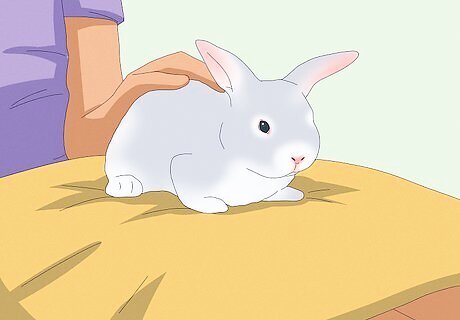
Pet your rabbit in the right places. Rabbits can be particular about where they are touched. Their favorite areas are on the cheeks, forehead, shoulders, and back. These are areas where rabbits usually groom each other, so they'll appreciate you petting them here. Stick with these areas to ensure your rabbit is happy and has a good experience. Generally, don't try to rub their chins. Unlike cats or dogs, rabbits don't usually like getting their chins scratched and it puts you in easy reach to receive a bite. Also avoid trying to pet your rabbit's stomach or paws as these are vulnerable areas for them.
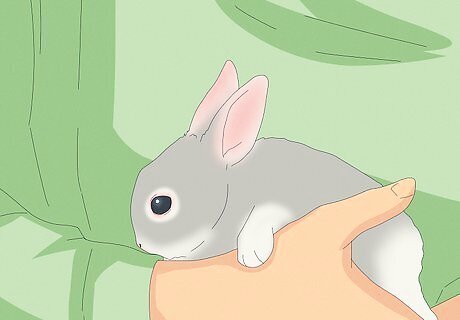
Pick up your rabbit with care. Rabbits need to be gradually introduced to being picked up, possibly over several days or more. It is an unnatural experience that they have to get used to. If your rabbit has never been picked up before, don't try to pick him up right away. Read Pick up a Rabbit for an explanation on how to pick him up safely.
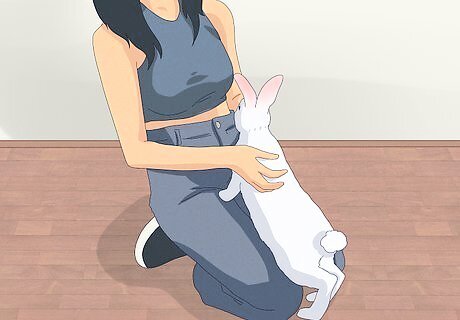
Pay attention to your rabbit's mood. Your rabbit will give you signals indicating whether or not he's happy. Pay close attention to these signals, because you wouldn't want to go on doing something that your rabbit doesn't like. Purring and light tooth clicking indicates that your rabbit is happy. Rolling over, climbing on you, placing his head on the ground, licking, and nudging you with his nose also indicate happiness and desire for attention. Keep petting your rabbit if he does these things- he's having a good time. Growling, grunting, and squealing indicate fear or pain. Stop petting and put him down until he gets relaxed again. Rabbits also sometimes go up on their hind legs and put out their front feet like they're going to punch you. This is a defensive posture (but can also mean it wants to look at something higher up and needs a better view) and you should leave your rabbit alone if he does this. If your rabbit turns around and tries to get away, let him go. He may be tired or scared, and forcing him to play will make it worse. Let him go back to his cage and rest before trying to play again.
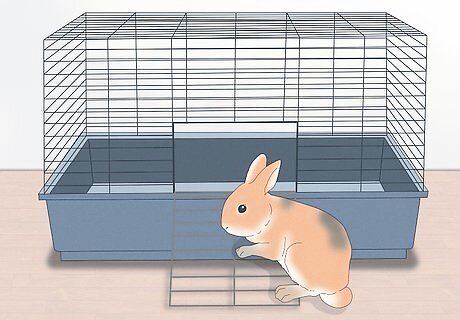
Get your rabbit back in his cage carefully when you're finished. Rabbits, especially young ones, can be defiant and resist going into their cages. Since it can be dangerous to pick up your rabbit abruptly, you should only force him into his cage if it's an emergency. Rabbits will usually go into their cages by themselves when they're tired. If you're in a hurry, coax them inside by placing a treat in the cage. It also helps to make sure the cage is set up properly so your rabbit will be comfortable going back in. Read Raise a Healthy Bunny for details on how to set up your rabbit's cage and what treats are safe to give him. Also don't force him out of the cage. Rabbits like to have a space that they can retreat to and relax. When they want to play or explore, they'll come out on their own. Leave your rabbit alone when he's in his cage, unless you suspect he may be hurt or sick. Otherwise, let him come out when he wants to.










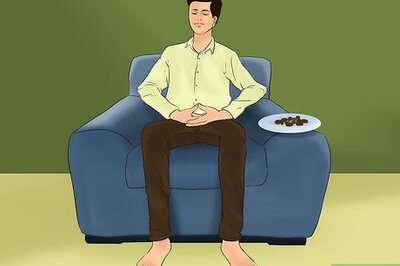









Comments
0 comment